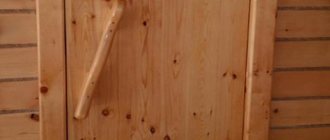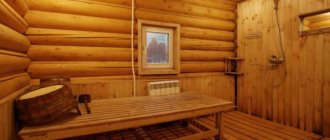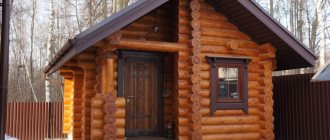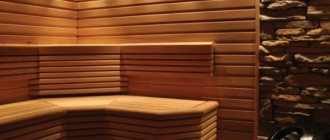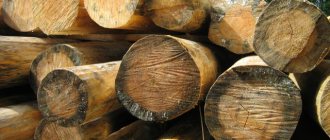How important is a good wooden handle for a bathhouse? The answer to the question is obvious. Try removing it from the doors and try to take a steam bath at least once without this extremely necessary element of door hardware. In addition, a bath handle for a good owner has always been and remains one of the ways to decorate the entrance, complement the door leaf, and make the facade brighter and more expressive.
Requirements for the design of a bath handle
Like all important things, it is impossible to make a handle for a bath door at random, without knowing how the material and design will behave.
It is always hot in the steam room of the bathhouse, and the entrance door to the steam room is usually built massive, with a tight fit in the frame. Therefore, the convenience and safety of using the steam room depends on how correctly the handle for the bath is made with your own hands. Bathhouse door handles must meet the following requirements:
- The body must be quite massive and durable. In the event of smoke in a steam room or bathhouse, it is much easier to see a bulky arc than a small ball of wood;
- The material should not absorb moisture, have low thermal conductivity and not emit volatile substances when heated.
Bathroom door handles are made of wood, no plastic, rubber, much less metal, even if the hand grip area is insulated with a fabric, leather or felt cover. It is not difficult to wash the body of the handle, but it is very easy to get a burn if you accidentally grip a metal part incorrectly in a hot steam room.
Contrary to popular belief, wooden door handles for bathhouses are quite durable and can serve their owners for one and a half to two decades.
Useful tips
When installing a door structure in a bathhouse, you should remember some nuances:
- It should be taken into account that the door will shrink after some time: a frame made of raw wood shrinks by approximately 8%, and a frame made of dry wood - by 2%.
- It is not recommended to install locks or latches on door structures leading to the steam room. This is done for safety purposes, so that it is convenient to get into the premises in case of accidents or emergency situations. In addition, at high temperatures, metal fittings heat up, and when exposed to steam, they quickly become unusable and can jam at any moment, which is very dangerous.
- It is strictly forbidden to treat the door leaf leading to the steam room with paints and varnishes.
- A threshold of 15-20 cm is always installed under the entrance door. Under the door structure leading to the steam room, a threshold is not installed, but a gap of 3 cm is made.
- The doors always open only outwards, and the hinges are mounted on the opposite side from the wet room.
Whatever doors to the bathhouse are chosen, it is important that they consist of moisture-resistant and sealed materials that can withstand constant pressure.
It doesn’t matter at all whether the door structure is made independently, in production, or purchased from an expensive, prestigious showroom. The main thing is how comfortable, reliable, aesthetic and easy to use it is.
Features of wood door handles
Since ancient times, door fittings have been made from wood. Later, they were given a worthy fight by steel products and elements made from modern materials. Even today, wood models are widely popular due to their advantages:
- Properly sanded and processed wood is soft to the touch. A wood handle is not as cool as a metal or plastic handle.
- Accessories made from wood are irreplaceable when arranging baths and saunas. Wooden elements do not heat up to enormous temperatures like steel ones, and the possibility of getting a burn when handling the handle is reduced to zero.
- Easy to make wooden door handles with your own hands. Wood is easy to process, and working with it does not require expensive equipment. Using bars, slats or logs, it will be possible to create a structure of any shape.
- Affordable price.
Despite the significant advantages, wood products also have some disadvantages:
- The strength properties of wood are inferior to steel elements. This fact must be taken into account when constructing a structure that is subject to significant loads. In this case, it is better to give preference to hard wood or metal.
- With prolonged contact with steel surfaces, the wood is destroyed. Based on this, door handles for doors must be selected in accordance with the material of the door leaf.
- In order for a wooden handle to serve for a long time, it must be carefully treated: sanded and impregnated with protective compounds.
Window in the rest room or dressing room
This is a room in which they relax between trips to the steam room, drink aromatic tea, and communicate.
Photo: the relaxation room for the bath should be warm so that the heated body does not freeze. Drafts must be avoided, so blowing through the window in the dressing room is unacceptable. © depositphotos The temperature in the dressing room is practically no different from an ordinary room, but the humidity may be increased.
For such a room, you can choose a window from any material - wood, aluminum, plastic. It is better to choose bath fittings with a good protective coating so that they do not rust in a year.
If the site allows, you can make a panoramic window in the relaxation room - contemplating the landscape outside the bathhouse window will help you relax even more.
What to expect from wooden crafts
Before getting to work, let’s evaluate the properties of homemade fittings. Advantages of a wooden handle:
- the design and shape of the product can be very different;
- natural material with low thermal conductivity causes pleasant tactile sensations;
- for the same reason, wood does not burn your hand on the bathhouse door;
- you don’t have to spend money on accessories;
- “metallists” will not take the pen for scrap;
- If it fails, you can make an even better one.
Disadvantages, as always, are also present:
- the service life of wooden crafts, especially outdoors, is limited;
- You will have to work hard to create a beautiful, comfortable and high-quality product.
GLASS UNIT
When ordering any window, it is important to choose the right glass unit, and for a bathhouse this is even more important.
Firstly, the double-glazed window must be warm - then it will save a lot of energy when heating the steam room.
Secondly, the double-glazed window must be heat-resistant, because ordinary glass is not designed to operate at temperatures below one hundred degrees.
Thirdly, the double-glazed windows should not be afraid of low temperatures - not all baths are heated in winter, and ordinary double-glazed windows are also not designed for this.
Therefore, we suggest using a special double-glazed window: double-chamber with energy saving and argon, and tempered inner glass.
Options for door handles for baths
Most owners of bathhouse apartments prefer to make wooden door handles for the bathhouse with their own hands. On the one hand, creativity and the opportunity to make an unusual door decoration design. On the other hand, it is better to do the most important things yourself.
There are an incredible variety of forms and options for constructing wooden door handles for a bathhouse. Starting from an intricate design in the shape of a ship's wheel, ending with a standard ball used for ordinary inter-apartment door blocks.
The most popular models:
- Handles in the shape of an arc nailed to the door leaf. The body can be carved from solid wood, a branch or a tree root. The outer surface is traditionally decorated with wood carvings;
- Straight, most often industrially made, without any decorative elements. Such models are used primarily for glass bath doors;
- Twin structures. In one product, a wooden handle is combined with a locking device or deadbolt;
- Compact furniture models made of wood, usually spherical, “umbrella” or “mushroom”.
There is a special category - carved wood compositions. Such products are made by professional carvers according to the individual order of the bathhouse owner. The handle for the bathhouse is ordered specifically to complement the design of the wooden entrance doors and the facade of the bathhouse.
According to the form and principle of operation
There are the following main types of door handles:
- stationary (brackets);
- fall ones with a push mechanism;
- halyard with a rotating mechanism (nobs).
Stationary handles are installed on the door using several screws or tension screws. They serve solely to pull the door when opening and push when closing.
Stationary handles do not interact in any way with either the latches or the lock.
According to their shape, this fittings are divided into several subtypes - there are U-shaped, spherical and round stationary handles.
Handles with a push mechanism are equipped with a latch, embedded in the door. The principle of their operation is as follows: when you press the handle, a spring is activated, retracting the latch into the “bowels” of the leaf - thus, the door opens. If the handle is not mechanically affected, the latch is constantly in the extended position.
This system is extremely convenient if there is a constant need for tightly closed doors in the house.
Worth knowing! All classic mortise locks are equipped with just such handles - with a push mechanism.
When replacing old lever handles with new ones, do not forget about the latches. After all, by purchasing fittings with latches that are different from the ones you already have, you are exposing yourself to unnecessary headaches - you will have to additionally cut and, possibly, patch the fabrics.
Installing door handles with your own hands will take you a matter of minutes if you select new elements with dimensions similar to the old ones.
Handles with a rotary mechanism (knobs) are spherical in shape. Often, a keyhole is integrated into their center. At the same time, they can be opened with a key only on one side; on the other side there is a locking button or latch. Such fittings are an excellent choice for internal doors, especially to the bathroom and toilet.
How to choose?
Door handles must necessarily be combined not only with the door itself, but also with the general character of the interior. When purchasing, it would be a good idea to evaluate the fittings by touch; evaluate how it lies in your hand and whether it causes any unpleasant sensations.
Also consider the degree of load on the handle. Agree, on a powerful, heavy door, the frail fittings will quickly become unusable - they simply will not withstand the efforts that you will have to put into manipulating the door.
Door handles differ in price just as much as in all other parameters. Depending on the shape and material, their cost can range from several hundred rubles to... an amount exceeding the cost of the door itself.
We solve the problem comprehensively
Proper layout of the premises is also important.
Many people, having spent good money on complete insulation of their bathhouse, suddenly discover that for some reason the desired insulation does not occur. Yes, it’s warmer, but where is the promised bliss, and why are there drafts across the floor?
The answer usually lies on the surface and whistles with pleasure - the door, the ordinary door to the bathhouse becomes the cause of this final inconvenience.
The solution to this problem can be very simple, or it can be a little more complicated, namely:
- Insulation of the door leaf itself;
- Insulation and sealing of joints where the door meets the jamb;
- Installation of thermal curtain;
- Installation of a second door.
Today we will go through all the points and be sure to solve two basic questions: how to insulate the door to the bathhouse and how to insulate the door to the bathhouse.
Let's get busy with the canvas
Photo of foamed polyethylene foil.
Any carpenter will tell you that it is not advisable to make the door structure heavier; moreover, this is fraught with distortions, and considering where the door is located (meaning in a bathhouse), then making it heavier is a completely unnecessary undertaking.
Therefore, in this section we solve the problems:
- Which insulation to choose so that it does not absorb moisture, can withstand low temperatures and is not very heavy;
- How to layer this insulation onto the door leaf.
We will not transmit the entire flow of information that the Internet is replete with about insulating fabric; we present a very simple method and its rationale:
As door leaf insulation, we offer you polyethylene foam with a foil layer. The material itself is quite resistant to cold weather, has the invaluable advantage of being wind and moisture impermeable, in addition, the foil layer will return heat flows back to the bathhouse. And the weight of the material will be slightly more than the total mass of the paint and varnish impregnation layers. The hinges will not experience a large load and the canvas will not move.
Regular door covering with this material.
From canvas to jamb
After insulating the door leaf, let's work on the jamb
The simplest thing is to trim the inner perimeter of the jamb with the door tightly closed (and note, already insulated)
In the old days, the most popular insulation for the front door was felt, but now you can use any other method. Basic requirements for the material: it must be soft enough, and at the same time fit tightly to the door leaf, thus preventing the access of air, and also not lose its qualities when in contact with water, not cake or tear.
The technology has not changed:
- The insulation is cut into thin narrow strips at least 5 cm wide;
- A 20x20 mm strip is marked and sawed off in such a way as to completely and tightly cover the internal perimeter of the jamb (taking into account the thickness of the insulation itself);
- The insulation is folded in half and installed with a fold to the door leaf as close to it as possible, pressed and fixed with a strip to the jamb;
- Thus, the entire perimeter of the doorway is covered.
Full guarantee
If you already want to get a full guarantee of protection from the cold, then you can finish insulating the door to the bathhouse by using a curtain made of dense material. You don't need instructions to cut and make the curtain. We chose the material, cut it, cut it, stitched the edges, thought out the fastening system and hung it. In this case, the fastening system can be under the rings on the pipe, simply overlapping the valve and stitching the valve under the pipe, or you can even make a cloth for clothespins (clothespin fastenings). There is also a simple way to attach between two planks. Therefore, we do not limit you in fastening and choice of material.
A few words about the second door
That's the point.
The second door is a method that has been tested and proven to be positive. Place your bet. To implement this, it is necessary to either install a jamb in which it will be technically possible to install two doors, while the adjustment of the two panels must be carried out before installation in the opening, which sometimes requires financial costs, time, and the warm season.
You can install an additional jamb and canvas to the existing ones, but you need to think about fixing the new structure to the existing one. A positive quality of the second door is the layer of air, which plays a buffer role and prevents the cold from quietly passing into the dressing room.
Let's make a simple handle with our own hands
Regardless of whether the wooden handle will be custom-made by a carver, or all the details, from the design to the installation on the bathhouse doors, will have to be done with your own hands, first of all, you need to choose the right type of wood and the shape of the workpiece.
Cutting a wooden handle from linden
The ideal option for a wooden handle, suitable for any bathhouse door, can be considered a simple arched model with a reach of 35-40 mm and a length of 25-30 cm. If you do not have much experience in carpentry, then it is best to start by making a wooden handle from linden wood.
Solid wood sauna front door product
After a round blank has been cut out of solid acacia, oak or walnut, it is necessary to mark the future base of the handle. The wooden base made of oak is much more difficult to cut, but at the same time it becomes possible to use a more complex product design.
The easiest way to make a wooden handle for the entrance door of a bathhouse is from two parts - the base and the holder itself. To achieve a harmonious combination, we cut out the base on a router in the form of a shaped platform with support spots for installing a holder. The dimensions of the supporting part of the curly handle should not be too large; a platform of 20x10 cm is sufficient.
Using a chamfer cutter we go along the contour of the wooden base, we get a nice fillet.
After milling the contour, the surface of the workpiece is cleaned with emery cloth.
To make a wooden holder, you can use a walnut or ash branch. The shape and size can be selected to match the design style of the bathhouse entrance door. The surface is cleared of bark and sanded.
The finished parts are connected with oak wooden pins; you can use metal fasteners, but then you will have to cut a steel bushing with an internal thread into the holder. As a result, you will need to make holes in the wooden case, or make the holder too massive.
After two wooden parts are connected into one structure, the holder and base are coated with varnish or epoxy compound and, after curing, they are attached to the entrance door of the bathhouse.
Since the entrance to the bathhouse is not much different from the front door of an ordinary house, the design of the wooden handle can be supplemented with decorative elements made of metal and plastic.
Lightweight version of a wooden handle for a bath
A homemade door handle will amaze the guests of the bathhouse and will become the pride of the owners of the steam room. Constructing a lightweight model will not be difficult. Let's look at an example of creating a pen with a length of 20 6 cm and a height of 10 cm. To work, you will need a board with dimensions of 26 * 10 * 5 cm, a light pencil and a jigsaw.
Door handle in Russian folk style
An example of a carved handle will harmoniously fit into an interior designed in a traditional folk style. The handle will perfectly complement an antique-style door. The design of the model includes 6 parts:
First you need to prepare each part separately, fit them together and polish them. Production order:
Determine the purpose and choose the method of making a homemade pen
Most often, a handle is used to open or close a door. In this case, you can make a latch, hook or bolt from wood that will fix or lock the door.
The products shown in the photo were made on a lathe. The small button-style handle consists of only one piece and is better suited for furniture.
To open a heavy door, it is better to make a full-fledged handle from three parts. I would choose the option with a crossbar that is inserted into the supports (above right), which provides the greatest strength to the craft.
Carved handles are good in their own way. There are an indescribable variety of options for such products. To make something like this, you need to have a set of cutters and artistic taste. At the same time, it is quite possible to process simple handles with a knife.
I advise you to take a close look at overhead handles: they can be simple, reliable and even sophisticated at the same time. Such fittings can be cut with an ordinary hacksaw or jigsaw.
If a three-piece handle is secured with self-tapping screws through the main element through the stands, the product will be very durable. The height of the stands should be ensured to provide sufficient clearance for fingers.
Flat handles are the most popular, and they are made from boards. I recommend the option located in the photo below right: it is the most reliable, since the handle opening is located below the screw heads. In this case, the craft will not break along the fibers.
To make fittings, you need to apply drawings of the parts on the plane of the board, and then cut the workpiece with a jigsaw. Of course, sanding will be required.
Holes for fastening should be provided. They are drilled out at the top with a large diameter to hide the screw heads.
Accessories made from natural materials can be decorated with carving elements, applied with drawings or icons using a burner, or treated with a blowtorch. A more complex version uses linings cut with a jigsaw. To attach a handle from a branch, you need to prepare several holes for self-tapping screws so that the fittings do not wobble and are held securely.
DIY wooden door handles: photo ideas
The design of door handles amazes with the variety of colors and designs. The fantasies of woodworking masters are embodied in unusual shapes, beautiful curves and stylistic execution of door accessories.
DIY turned wooden door handle
To make a turned handle for interior doors, you will have to master the skills of working on a lathe. Creating such a model requires the use of the following tools and materials:
- machine with three-jaw chuck;
- oak block;
- wood cutters;
- coarse and medium-grain sandpaper;
- wax mastic.
- Prepare the workpiece. Cut the square block a little along the edges on one side. Thus, the rounded part will be evenly fixed in the machine chuck.
- Insert the workpiece into the jaws and use a semicircular cutter to give it a cylindrical shape along its entire length.
- Level the surface of the block with the end of the cutter, holding it at a slight angle.
- Use the sharp edge of the cutter to shape the upper part of the handle.
- Step back some distance from the edge and carve out a base, the back of which will be adjacent to the door leaf.
- Trim the base of the handle with a straight cutter and sand the surface. When sanding, it is important not to overdo it and not to put too much pressure on the paper, otherwise you can burn your fingers on the rotating elements and ruin the product.
- Cover the handle with wax mastic. The product penetrates into the pores of the wood, protecting the material from external influences and giving the handle a matte shine.
- Using the point of the cutter, cut off the handle from the rest of the rough timber.
- Insert the handle into the door.
Main stages of work
The first step is to make a matrix and a punch. To do this, the master saws a wooden block into two parts with a jigsaw, having previously drawn on it the shape of the future door handle.
Then you will need a wooden strip of suitable length, which must first be kept in hot water for some time, and then given the desired shape using a homemade matrix and punch.
As for the material itself, you can use any wood, but if possible, try to choose oak, linden, birch and hornbeam.
Along the edges of the door handle, the master decided to make decorative elements in the form of leaves - an excellent option for a door to a bathhouse. Then you will need to drill holes for the mounting bolts. It is best to soak the product in mineral oil or coat it with wax.
Conclusion
Making a wooden handle for a bath door or front door is not difficult; you only need desire and a certain set of tools. In this matter, thoroughness and strict adherence to the technology of working with the material are important.
Voted over 252 times, average rating 4.8
Comments
Unfortunately, there are no comments or reviews yet, but you can leave your...
Add a comment Cancel reply
We recommend reading
Handles, Fittings Why are brass handles considered the best choice for interior and exterior doors? The functioning of any door is ensured by fittings. Locks …
Handles, Fittings How to find the right solution for determining the height of the door handle from the floor? If previously interior doors were the same type of solutions, ...
Handles, Accessories In what interiors can handles on a rosette be installed on the door? Interior and entrance doors are often equipped with a locking mechanism and…
Handles, Accessories How to disassemble and replace a door handle with your own hands in 10 minutes? Door handles, like any mechanism, are subject to malfunctions and...
Advantages and disadvantages of the material
Despite the widespread use of composite and synthetic materials, wooden door handles for bathhouses are always popular. In addition, such a door handle looks best on a wooden canvas.
Key advantages of a handle for a wooden canvas:
- This product, like the high-quality polished canvas and the box, is pleasant to the touch.
- When arranging baths, fittings made from natural materials are simply irreplaceable. A box, canvas, or wooden handle will prevent you from getting burned.
Bath door handles
- It’s easy to make it from a pliable material and install it on the door with your own hands, which will save money on the purchase of other bath accessories - brooms, rugs, hats.
- It is possible to create different sizes and shapes from leftover material from the manufacture of boxes and canvas.
- To make handles for a cabinet or an interior door, you can use a board made of any type of wood.
Products with decorative firing
There are also a number of disadvantages. Among them:
- The strength of such fittings is less than metal ones. If you want to see just such a model on the canvas, it is recommended to choose a board made of durable wood, the same as for the box.
- A handle should be made from wood only if the blade is made of the same material, otherwise it will quickly fail.
- The door handle, as well as other door elements, including the frame, are carefully treated with special compounds for durability.
How to choose the right material for a wooden handle
To make a bath handle, you first need to decide on the location of its installation. If you need to equip doors to a steam room, there are few options for suitable wood. The wooden blank for the future product must be cut from linden.
Linden wood has two very important advantages:
An exterior door will require very strong and hard wood. You cannot use beech, larch, aspen, spruce; their wood is prone to splitting and at the same time produces a large number of splinters.
A wooden handle can be made from acacia, walnut, elm, or any heavy wood with an interwoven fiber structure. To cut the workpiece, you will first need to cut one “round timber” 30-35 mm thick from the trunk or stump, mark it along the contour of the future product, and only then cut it with a jigsaw.
Varieties
Each bathhouse has several different rooms:
- dressing room;
- locker room;
- washing room;
- steam room
There may be additional rooms, and each requires its own door design.
At a minimum, two such structures must be installed in the bathhouse:
- external entrance door for the bathhouse;
- internal door to the steam room.
Based on the material of manufacture, there are three options for choosing for the manufacture of door structures for bathhouses or saunas.
Wooden
Original carved door for a bathhouse made of linden.
The wooden door leaf is made from tongue-and-groove boards and then covered with clapboard (see also the article “Do-it-yourself wooden doors to a bathhouse - manufacturing technology”). The material for such structures must meet the stringent requirements for this product. It happens that doors are made with artistic carvings, but in this case their price increases significantly.
Let's look at the materials that can be used:
Glass
The advantage of tempered glass doors is their ability to withstand high temperatures.
Recently, door structures for baths and saunas made of special tempered glass have become especially popular. They are especially often installed in saunas and Turkish baths.
The material for such structures is durable 8mm tempered glass.
This glass has all the necessary qualities, it:
- water-repellent;
- heat-resistant, can withstand temperatures up to 300 °C;
- safe;
- inexpensive;
- easy to maintain, easy to wash and clean;
Combined
The photo shows a variant of the combined design for the entrance to the sauna.
The combined version contains wood and glass, which is very convenient and beautiful. Usually, a window insert of different sizes is made into the frame, which is made of wood of suitable species. It can be the size of almost the entire canvas or very small, as you like.
Material selection
If the product is intended for the entrance panel, it is made from strong, good quality wood. There are recommendations to use coniferous wood, because, among other things, they exude a pleasant aroma and have an antibacterial effect, and the material itself is inexpensive, and you can also make a box from it.
Note! The safest board in terms of cleanliness (does not emit resin) is made from hardwood; it is also usually used for door frames.
Wooden material
Options for wood material from which to make an excellent door handle:
- Oak is a durable material, and products made from it are the same. oak is resistant to mechanical stress, looks respectable and will suit the entrance group (leaf and frame) made of oak in a country cottage.
- Beech is a valuable material, its properties are equal to oak. A distinctive feature is its uniform texture.
- Poplar is distinguished by bactericidal properties, which is why such door fittings are used to decorate the door in the bathhouse.
- Linden has a calming effect on the human body. This material is often used in the bedroom.
Options for wooden door handles
If the walls are made of logs or timber
A wooden bathhouse made from a log or timber is quite common, and the installation of doors in such a bathhouse differs in technology from a similar installation in a room with walls made of a different material. The fact is that wood constantly changes its overall dimensions, and this has to be taken into account in buildings made from it.
In particular, the installation of doors and windows is usually accompanied by the creation of a specific frame. This is a well-known tongue-and-groove connection, which creates the possibility of the box sliding during the period of continued shrinkage of the wooden frame.
Pit under the door in a chopped bathhouse
IMPORTANT! An increased vertical opening size is mandatory - the gap between the jamb and the wall is needed for the future if the height of the log house is reduced. If it suddenly turns out that you made it too large, then you can make a transom above the door. The “tenon and groove” can be done in any way you like - cut a groove in the logs or, conversely, cut a tenon in the wall and a groove in the frame
Both options are viable. The tools usually used are a hand-held power saw and chisels. However, it is worth warning in advance that the work is not the easiest and will take quite a lot of time.
The “tenon and groove” can be done in any way you like - cut a groove in the logs or, conversely, cut a tenon in the wall and a groove in the post. Both options are viable. The tools usually used are a hand-held power saw and chisels. However, it is worth warning in advance that the work is not the easiest and will take quite a lot of time.
Manufacturing methods
There are two popular ways of making products from wooden material:
- turning;
- thread.
Turned products
Such parts are made on a lathe; the product cannot be manufactured without special tools. “Balls” and “mushrooms” are made using a similar method. The manufacturing process consists of several stages.
"Mushrooms"
You will need a blank - a wooden board (block) with a section of the required size, which is selected in accordance with the parameters of the product. Leftovers from making the door frame will do. The board must be dry, intact, without cracks or other defects.
Note! The integrity of the blank board is important both for the aesthetics of the finished door handle and as a safety requirement, because such a blank can break at any time during rotation and injure your hand.
“Mushrooms” from a lathe
Manufacturing stages:
- An octagon is made from a blank board; a plane is used for this. It’s faster to work with an electric planer, but if you don’t have one, then a regular manual one will do.
- Next, the hewn workpiece is clamped on a lathe and a cylinder is formed using a chisel.
- Next, markings are applied to it for the future part. The product is formed using a semicircular or beveled cutter.
If you need to make handles for several canvases, then take a block of such length that it is enough for 3-4 copies, then saw them. The surface finishing is done manually using fine sandpaper.
Assortment of turned wooden handles
Carvings
This model is easier to manufacture and does not require special equipment such as a lathe. Tools and materials you will need:
- Board.
- The branch is of a non-standard shape and of such a size that it is convenient to grip the door handle.
- Saw, jigsaw.
- Milling cutter and attachments are optional.
- Drill or screwdriver.
- Sandpaper or sander.
- Clamp.
- Epoxy adhesive.
- Varnish.
- Nog.
Handle blank
Sequence of work
- Clean the board from bark and sand it. Apply a drawing of the future base for the pen onto the prepared surface.
- Cut the workpiece along the contour, thereby giving it a suitable shape.
- Sand the sides and make a shaped notch along the edges using a router.
- The handle itself consists of an unusually shaped tree branch. Remove the bark from it, if necessary, trim and sand it.
- Trim the branch so that it is in tight contact with the prepared board.
- Connect the branch and the base under it using glue. For permanent fixation, clamp with a clamp.
- Drill holes in the base so that they go to the base. Drive the dowels there, pre-coated with glue. Remove the excess length of the pegs.
- Dry the assembled product overnight.
- Cover with varnish or paint after drying and mount on the door.
Installing handles on interior doors
Inserting handles into interior doors with your own hands begins with marking the location of the fittings. In accordance with established standards, a standard door handle is installed at a height of 80-100 cm from the floor (depending on the height of the residents). The work is carried out in the following sequence:
- Mark the installation location on the door leaf, moving at least 6 cm away from the edge.
- Using a ruler, draw a straight line across the end of the door and continue marking from the back of the door.
- Use a drill to prepare a hole ½ the thickness of the door.
- Repeat drilling on the 2nd side of the blade. It is important that there is no deviation of the hole axis horizontally or vertically.
- Use a chisel to knock out a niche for mounting the latching mechanism.
- Insert the latch and check that its edge is in the same plane with the door leaf.
- Place the two parts of the handle on different sides of the door and guide them through the hole. Tighten the structure with bolts.
- Finish the end of the box with a steel plate - prepare a selection for the tongue and frame, try it on and secure the plate with self-tapping screws.
Over time, you may need to do some minor DIY repairs to interior door handles. At times, to prevent the elements from becoming loose, it is enough to tighten the screws with a screwdriver.
